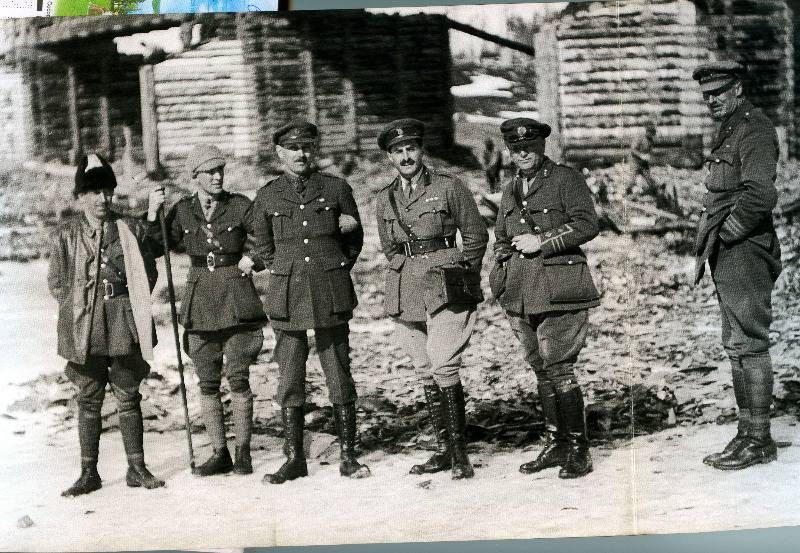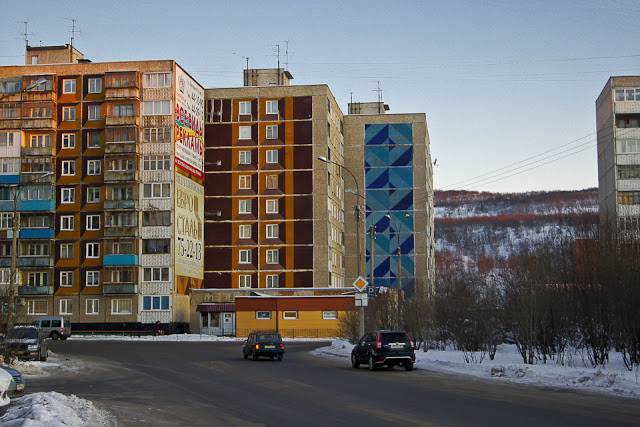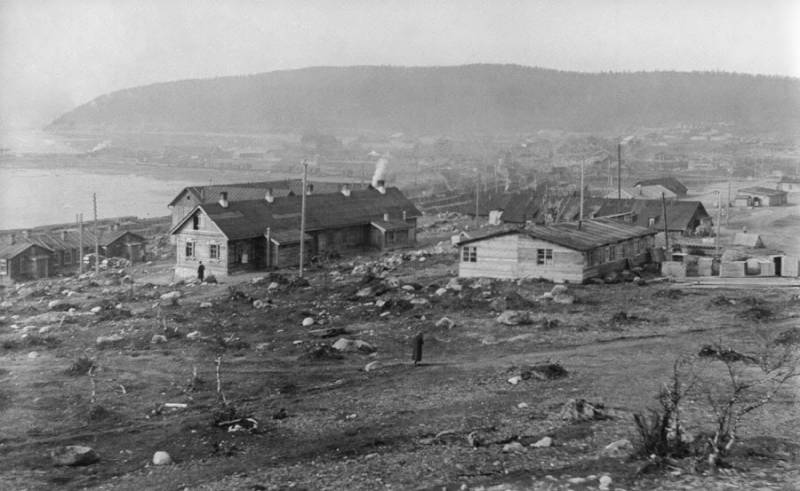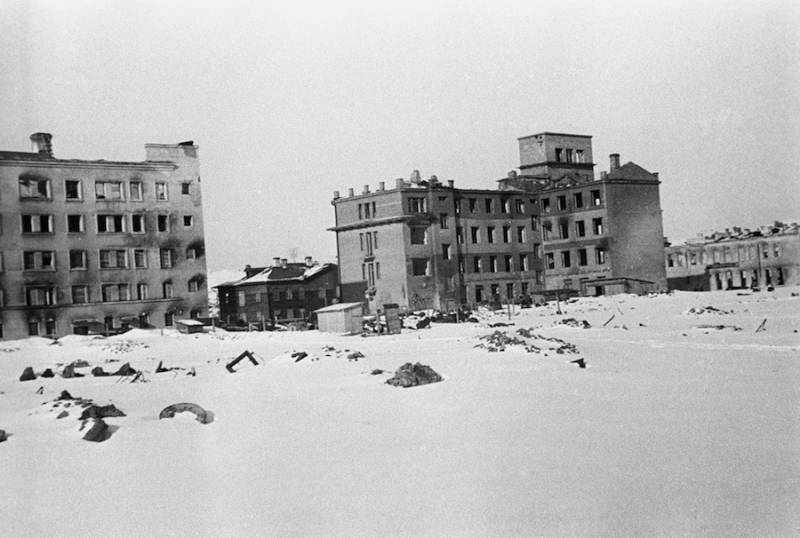One hundred years the capital of the Arctic. The anniversary celebrates the city of Murmansk
21 September (4 October) 1916, the port village of Semenovskiy, founded in 1915 at the port of Murmansk, was officially proclaimed a city called Romanov-on-Murman. It was the last city founded in the Russian Empire. The Murmansk coast was named this way because its closest neighbors — the Norwegians — were formerly called Russian residents “Murmans,” that is, “Normans.” Accordingly, the Murmansk coast is Russian “Normandy”.
In fact, it was planned to build a city on the Murmansk coast since the 70-s of the XIX century, however, there were constantly some obstacles to the realization of what was planned, first of all, the insufficient level of development of these northern lands. Only in 1915, when World War I was already in full swing, and Russia needed a detour to link it with Great Britain, the Murmansk Sea Port was founded on the right bank of the Kola Bay of the Barents Sea. Under him, the port village of Semenovsky appeared, in which the attendants lived. The port village was named in honor of the Semenov bay. A year after its foundation, in the autumn of 1916, the village of Semenovsky was proclaimed a city. From the earliest days of its existence, Romanov-on-Murom became a strategically important city in the northern part of the Russian state, both naval and economic. A few months after its foundation, the February revolution of 1917 took place in Russia - an event that transformed the entire subsequent history of the Russian state. Romanov-on-Murman 21 March (April 3) 1917 of the year was renamed Murmansk. So the city adopted its modern name. When the October Revolution occurred, the Murmansk Bolsheviks created a temporary revolutionary committee.
The signing of a peace treaty with Germany created the risk of establishing the control of German troops over the strategically important ports of Arkhangelsk and Murmansk. This was most feared by the leaders of the Entente countries, who decided to hold an armed intervention in the north of Russia in order to protect the northern ports from the Germans and the Bolsheviks and to support the anti-Bolshevik intervention of the Czechoslovak Corps. In addition, the Entente was closely watching the events in Finland, the declaration of independence of which turned into a confrontation between the red Finns, supported by Soviet Russia, and the white Finns, behind whom stood Germany.
For help in conducting the intervention, the United Kingdom and France turned to the United States of America. Thus, the expeditionary forces of the interventionists included a British fleet of 20 ships, five-thousand American expeditionary corps, 14 battalions of Canadian and Australian infantry, 2000 French soldiers, 1000 British, Polish and Serb riflemen, who were to go to help the Czechoslovakians, who were sent to help the Czechoslovakians. . 6 March 1918 English marines landed with two artillery guns in Murmansk. Thus began the Northern intervention of the troops of the Entente countries on the territory of Russia. Allied forces were in northern Russia before 176.

Their evacuation was caused by the end of the First World War, the defeat of Germany and, accordingly, the disappearance of the need for military presence on Russian territory. The successful advance of the Red Army in the northern regions also played its role. 20 February 1919 The Red Army occupied Arkhangelsk, and 21 February, as a result of an armed uprising, Murmansk passed into the hands of the Bolsheviks. A new, Soviet page began in the history of the northern city.
It was during the years of Soviet power that Murmansk became a major economic center, which has enormous significance for the country. By the time the city was liberated from the invaders, it had only two and a half thousand inhabitants. The main occupation of the local population was all kinds of handicrafts and fishing. Not pleased with the appearance of Murmansk, nicknamed the "red city" because of the accumulation of a large number of red "teplushek" - cars adapted for housing. The beginning of industrialization in a few years turned Murmansk into a modern industrial city. It became the main base of the Soviet fishing fleet in the north of the country.
The fishing industry has become one of the main pillars of the national economy of Murmansk. During the first five-year plans, special attention was paid to the development of fisheries and fish processing in Murmansk. A modern fishing port was created, fish processing enterprises were opened, which made it possible to turn Murmansk into one of the main suppliers of fish for the Soviet food industry and trade. In nine years, from 1928 to 1937, the number of fish products produced by Murmansk enterprises increased from three to sixty. The fishing fleet to 1937 year consisted 70 trawlers. In 1937, the world record was set in terms of the volume of fish caught - RT “Kirov” caught 60 thousands of centners of fish at a time.
The Soviet leadership was given the task of mastering the Arctic spaces, which, it must be said, was able to be almost completely solved. The most important role in the penetration into the Arctic was to be played by Murmansk. It was from Murmansk that the Chelyuskin steamer went on his famous march along the Northern Sea Route with the expedition of the famous scientist Otto Yulievich Schmidt. Murmansk served as a starting point for sailing the Taimyr and Murman steamers, which were sent to rescue the participants of the North Pole-1 station headed by Ivan Dmitrievich Papanin from the ice floe. In 1937, the Murmansk Directorate of the Main Sea Route was sent to the steamer 44 flights, and in 1939 the Murmansk State Sea Dry Cargo and Passenger Shipping Company began operating.
Since 1930, Murmansk has begun to play a special role in ensuring the defense and security of the northern borders of the Soviet state. In 1933, the Northern Navy was created, which four years later, in 1937, was transformed into the Northern Fleet. The first two years, before 1935, the Northern Fleet was based in Murmansk, and then transferred to the naval base in Polyarny.
In 1938, a new page in the history of Murmansk turned over - the city became a regional center. Prior to this, the territory of the modern Murmansk region was part of the Murmansk District of the Leningrad Region and the Kandalaksha District of the Karelian Autonomous Soviet Socialist Republic. However, considerations of an economic, political and cultural nature forced the Soviet leadership to create a new region in the north of the European part of the RSFSR - the Murmansk region. About 70% of the territory of the region fell on the Kola Peninsula. After the Soviet-Finnish war 1939-1940, in which Murmansk also had an important role to play, the western part of the Rybachy and Sredniy peninsulas entered the region. Despite the small population (in the whole Murmansk region even a million people do not live even now - the number of inhabitants in the region varies within 762 thousand people), the region quickly became one of the most important and noticeable regions in northern Russia.
During the Great Patriotic War, Murmansk was to play a key role in the defense of the northern borders of the Soviet Union and, last but not least, in transport communication with the allies. Valuable cargo from the countries of the anti-Hitler coalition came to the Soviet Union through the Murmansk port. For all the war years, the Murmansk seaport received 250 ships and handled two million tons of various cargoes from allies.
Adolf Hitler, perfectly understanding the strategic importance of Murmansk, ordered to seize the city and port in order to prevent the possibility of supplying the Soviet troops with allies. German military leaders expected to take a small city in a few days. However, both offensives failed. Then Hitler’s aviation began massive bombing of Murmansk. During the war, 185 thousand bombs were dropped on the city. 792 air raids took place, on some days up to fifteen to eighteen air raids per day.
Such a fierce onslaught did not know any Soviet city, except for Stalingrad. Hitler's aviation destroyed three-quarters of the city’s buildings. Considering that Murmansk at that time was built up mainly with wooden houses, Hitler's aviation bombarded it with incendiary bombs. In Murmansk, fires began, most of the buildings burnt out. Only 7 of October 1944 in the Arctic began the Petsamo-Kirkenes offensive operation. During the fighting, Soviet troops managed to eliminate the threat to the city of Murmansk. The Petsamo-Kirkenes operation led to the complete defeat of the Nazi troops in the region in less than one month. Soviet troops restored the state border of the Soviet Union. Our troops also entered northern Norway, which was also liberated from the Nazi occupiers.
During the war years, about one hundred and fifty participants in the fighting on the Kola Peninsula were awarded the title Hero of the Soviet Union. Twice the Heroes of the Soviet Union were three people. This is the renowned intelligence officer, the commander of the 181-th special reconnaissance detachment of the Northern Fleet, Lieutenant Viktor Nikolayevich Chauv (1916-2003), the commander of the squadron of 1-boats of the torpedo boats (team of the Northern Fleet's torpedo boats), Lieutenant Commander Alexander Osipovich-Shakht-Shakht-Shakht-Shakht-Shakhtar, the team of the Northern Fleet torpedo boats of the Northern Fleet, Lieutenant Commander Alexander Osipovich-ch Shakhtinch Shakhtinch Sharp (Brigade of torpedo boats of the Northern Fleet), Lieutenant Commander Alexander Osipovich-ch Shachi-ch Shachi-Shch Service Chief and the commander of the 1914 Guards Combined Red Banner Air Regiment of the Northern Fleet Air Force Lieutenant Colonel Boris Feoktisovich Safonov (1982-1942) who died in 2 year. The memory of them is still alive in the hearts of not only the residents of Murmansk, but also other regions of our country.
In 1985, in the year of the fortieth anniversary of Victory over Hitler's Germany, Murmansk became a hero city, the twelfth in the Soviet Union (after Leningrad, Odessa, Sevastopol, Volgograd, Kiev, Brest Fortress, Moscow, Kerch, Novorossiysk, Minsk, Tula). In the same year, he was awarded the title of hero-city and Smolensk.
After victory in the Great Patriotic War, the city was to be rebuilt. German bombardment caused numerous fires, so almost all city buildings were burned down. Only stone houses in the central part of the city and port facilities have been preserved. Therefore, the Soviet leadership included Murmansk among the fifteen cities of the Soviet Union, which should have been restored in the first place. It must be said that the townspeople and the forces brought to their aid coped with this task very quickly. By the beginning of the 1950-s, the city was largely restored, moreover, its accelerated development began. New houses, schools, medical facilities, industrial enterprises were built. Already in 1952, the city reached the pre-war level in terms of the number of residential buildings, and by 1962, the housing stock had tripled. This was facilitated by the start of construction of model panel houses after the launch of the house-building plant in 1962.

The collapse of the Soviet Union and the negative events in the economic life of the country affected the life of Murmansk. At the beginning of the 1990-s, active housing construction ceased. In 1990, the Northern Sea Route practically ceased to use, which resulted in the inevitable decline of the Murmansk seaport. This was reflected in the overall level of economic and social development of the region. From Murmansk and the Murmansk region, people began to move rapidly to more southern regions of the Russian Federation. Over the 25 years of post-Soviet Russia, the population of Murmansk decreased from 473 thousand people in 1991 to 301 thousand 572 people in 2016. This sad dynamics in the demography of the city was a direct consequence of the undermining of the economic foundations of the city. Only from the beginning of the 2000-s, Murmansk began to noticeably “come to life”, and the port of Murmansk, which switched to the export of goods, actively earned. It is in the Murmansk region that many shipping companies are based, a rescue fleet and, most importantly, a unique nuclear icebreaking fleet that provides year-round navigation along the Northern Sea Route. The Murmansk port plays an important role in servicing large-capacity vessels that transport oil, oil products, gas, mineral fertilizers, and metals. Such giants of the Russian fuel and energy complex as Gazprom and Rosneft view Murmansk as a promising platform for the construction of offshore platforms and the creation of logistics bases.
Relative development has also been received in the field of education. The largest universities of the city are the Murmansk State Technical University and the Murmansk Arctic State University, about half of the total number of Murmansk students enrolled in them. In 2017, the city plans to open a branch of the St. Petersburg Nakhimov Naval School. Such an order was given to the Russian Ministry of Defense by President Vladimir Putin.
Of course, it is still far from the pre-reform state, but advances are already noticeable. So, the Northern Sea Route is being revived. However, numerous old problems remain. In particular, the problem of building new housing is acute. Much of Murmansk is still represented by wooden buildings. In any case, the largest polar city in the world has potential for development, and it is not small.
- P P 'SЊSЏ RџRѕR "RѕRЅSЃRєRёR№
- http://vmnews.ru/, http://www.kolamap.ru/, http://www.may9.ru/, http://istomin-travel.blogspot.ru/,


Information